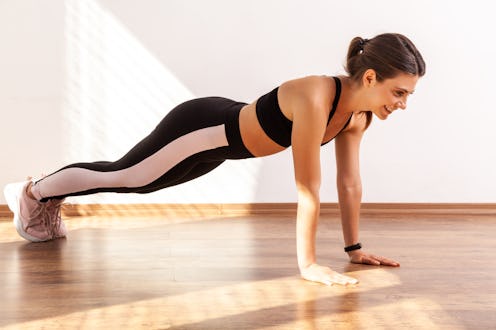Fitness
3 Mistakes To Avoid When Doing A Plank Exercise
Doing it properly will give you more bang for your (sweaty) buck.

While the exercise is fairly straightforward, learning how to do a plank in perfect form will show just how nuanced the staple ab move is. Sure, you’re simply holding yourself up on your hands and feet, but there are several mistakes that are easy to make — all of which render all that core-shaking effort null.
Doing a plank is, after all, fairly exhausting. But it’s tough for a reason: Despite its reputation for being an ab burner, it’s a full-body strength exercise. “When executed with proper form, a plank works a variety of muscle groups, including the chest, back, abdominals, shoulders, glutes, and inner thighs,” says fitness trainer Kim D’Agnese. You have to engage all of those muscles at once in order to balance, hold your body weight off the floor, and keep your body in proper alignment.
There are quite a few plank variations to choose from, from the standard high plank to the forearm plank and oblique-strengthening side plank. Though each is technically a full-body exercise, D’Agnese says different types of planks give more targeted love to different areas. “ A side plank works the obliques and lats, a forearm plank works deltoids and abdominals, and a full arm plank is more about the chest and abdominals,” she explains.
To nail the OG version of the move, keep reading for details on how to do a high plank along with the common form mistakes to avoid.
How To Do A Plank
Here, D’Agnese shares how to do high plank using the correct form:
- Begin on your hands and knees in a quadruped position.
- Place your palms under your shoulders, widen your fingers, and push into the ground as you lift yourself up. (Think of the push-up position.) Your arms should be straight, but not locked.
- Step your legs out straight behind you, tuck your toes under, and lift your knees off the floor.
- Walk your feet together to engage your inner thighs.
- Squeeze your glutes and keep the abs lifted to the spine.
- Make sure your hips are in line with your shoulders to maintain a flat back.
- Slide your body slightly forward so your chin is over your thumbs.
Try holding the plank for 30 to 60 second intervals. “You can increase time the stronger you get,” says D’Agnese.
Plank Modifications & Variations
To make your plank a little easier, lower into a forearm plank. “Bring your forearms down to the mat and place your elbows under your shoulders,” Amanda Jenny, the founding instructor of fitness studio bande, tells Bustle. “Open your forearms away from one another, so they are like train tracks or the number 11, and place your palms flat against the mat.” Try to hold for 15 seconds. “Once that no longer feels like a challenge, start to increase your time,” she suggests.
A forearm plank is a great modification if you tend to notice annoying tension in your neck and/or lower back when doing high planks. To feel even more supported and stabilized, drop your knees down to the ground. “You can also come to all fours on your hands and knees and build your strength from there,” says Jenny.
Another option is to place your hands on a sturdy bench as you do a plank. Step your feet back and get into the position with your upper body elevated, Jenny says. Continue to focus on maintaining that straight form, and then move on to the other plank variations once you’re ready.
To take your exercise to the next level, try raising a leg when you’re in a high plank. Hover your foot a few inches off the ground, then switch to the other leg. You can also reach your arm out in front of you, and alternate extending your opposite arm and leg. For an even bigger challenge, add a resistance band by placing it around your ankles and/or your hands (depending on where you want to feel the burn).
Form Mistakes To Avoid
To get the most benefit out of the exercise, don’t focus on how long you can hold a plank — instead, pay attention to keeping your body straight and in proper alignment so you can effectively hit all the right muscles. “That’s the most important element,” Jenny says. “Once you feel you’re losing your form, take a break, shake it off, and then try to come back into it with proper form again.”
Common mistakes include locking your elbows, letting your hips sag down in the middle as you get fatigued, and lifting your butt up as a way to make the move easier. It’s much more beneficial to do a modified plank perfectly than it is to do a trickier plank with bad form. While any variation of the exercise will make you stronger, proper alignment is key to really rocking your core.
Studies referenced:
Experts:
Kim D’Agnese, trainer
Amanda Jenny, trainer
This article was originally published on